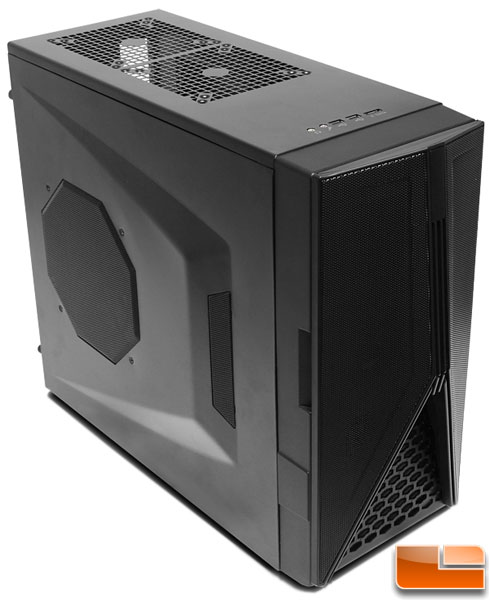NZXT Hades Black PC Gaming Case Review
By
External Impressions

NZXT seems to have adopted the all-black case look for most of their new cases, having a black painted interior which all enthusiasts admire upon sight; I know I sure don’t want a case painted any other way. The top of the Hades offers space for two 140 or 120mm fans and a dual radiator for all the water cooling junkies out there, with one 140mm fan pre-installed. The shape on the sides of the Hades is mirrored and is identical to the motherboard tray side door found on the NZXT Tempest EVO with the addition of a small mesh vent. The front of the door is where you will find the three temperature displays, status lights and hidden power button (simply looks like part of the styling). The side and front fans are both a monstrous 200mm in diameter.


The front panel inputs are very easily accessible and clearly labeled on the top of the case with two USB ports, audio and an E-SATA port.

From the head on perspective you can better see the small LCD display and status lights which are directly above the power button.

Through the mesh vents you can easily see the screwless drive bay clips, as well as the bright white 200mm fan with an additional dust filter.

Upon opening the front door, you have four 5.25″ drive bays with some more steel mesh for the bay covers. Sadly, there are no 3.5″ drive bays or adapters so those with floppy drives or people like me that have a 3.5″ card reader are out of luck (unless you want to take a jigsaw or a dremel to a drive bay cover like I plan to do, as I use my card reader daily) but that ghettomod is a project for another day as few people use such card readers. On the back side of the door there is a button that reads C/F which is the Celsius / Fahrenheit switcher for the front LCD display which is easily accessible while looking at the display itself.

The door is held on by two brackets, one of which carries all the wiring from the door elements, and is held shut by two magnets at the top and bottom of the door as shown above. It closes itself when it is slightly less than two inches open.

The fan controller works on two fans, the front 200mm LED fan and the side 200mm fan, and supplies eight watts per channel. Now eight watts does not sound like much, but it is more than enough to power these 150 CFM turbines that NZXT calls case fans.

The reset button found behind the door is the only exposed part that is neither black nor white (other parts: screws. That’s it.), but there is nothing wrong with a little stainless steel, so let’s move on

From behind the case you see a fairly standard appearing bottom-mount PSU ATX case, a 120mm fan, two water cooling pass-throughs (~2cm or ~3/4″ diameter), and very limited space above the I/O backplate which means the motherboard is crammed at the top of the case. Hopefully I will not need to get too creative to make room to plug things into the motherboard, but we shall see.

The bottom of the case isn’t much to look at — just four 1/2″ rubber feet glued on (screws would be preferred as glue will never stop them from moving around if you hit one while moving the case on the floor) and, of course, the plastic PSU vent filter. Note the front panel snaps in place. That is always a nice feature.
Now let’s open it up and better see what we are going to be working with.

Comments are closed.